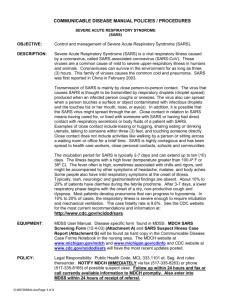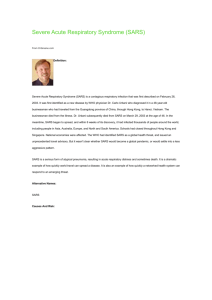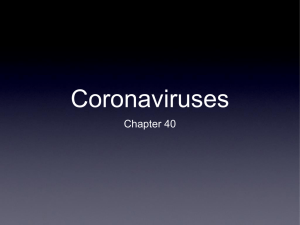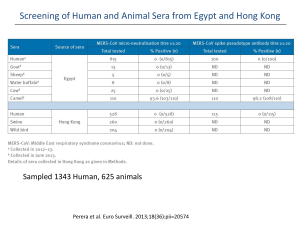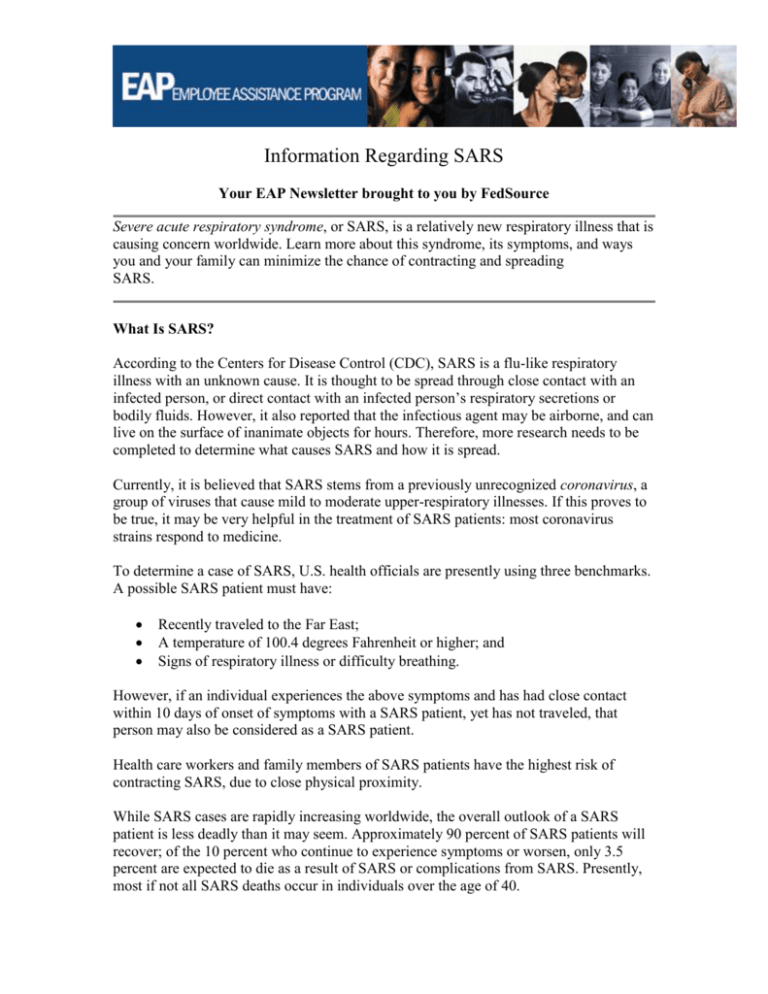
Information Regarding SARS
Your EAP Newsletter brought to you by FedSource
Severe acute respiratory syndrome, or SARS, is a relatively new respiratory illness that is
causing concern worldwide. Learn more about this syndrome, its symptoms, and ways
you and your family can minimize the chance of contracting and spreading
SARS.
What Is SARS?
According to the Centers for Disease Control (CDC), SARS is a flu-like respiratory
illness with an unknown cause. It is thought to be spread through close contact with an
infected person, or direct contact with an infected person’s respiratory secretions or
bodily fluids. However, it also reported that the infectious agent may be airborne, and can
live on the surface of inanimate objects for hours. Therefore, more research needs to be
completed to determine what causes SARS and how it is spread.
Currently, it is believed that SARS stems from a previously unrecognized coronavirus, a
group of viruses that cause mild to moderate upper-respiratory illnesses. If this proves to
be true, it may be very helpful in the treatment of SARS patients: most coronavirus
strains respond to medicine.
To determine a case of SARS, U.S. health officials are presently using three benchmarks.
A possible SARS patient must have:
Recently traveled to the Far East;
A temperature of 100.4 degrees Fahrenheit or higher; and
Signs of respiratory illness or difficulty breathing.
However, if an individual experiences the above symptoms and has had close contact
within 10 days of onset of symptoms with a SARS patient, yet has not traveled, that
person may also be considered as a SARS patient.
Health care workers and family members of SARS patients have the highest risk of
contracting SARS, due to close physical proximity.
While SARS cases are rapidly increasing worldwide, the overall outlook of a SARS
patient is less deadly than it may seem. Approximately 90 percent of SARS patients will
recover; of the 10 percent who continue to experience symptoms or worsen, only 3.5
percent are expected to die as a result of SARS or complications from SARS. Presently,
most if not all SARS deaths occur in individuals over the age of 40.
Typical Symptoms
The symptoms of SARS vary as the syndrome progresses, but it starts with fairly typical
flu-like symptoms. In the first few days, the symptoms may include:
A fever greater than 100.4 degrees Fahrenheit;
Chills, headache, malaise or body aches; and
Mild respiratory symptoms such as difficulty breathing.
After three to seven days, symptoms may progress to include:
Dry coughing that is unproductive; and
Insufficient flow of oxygen to the blood.
If the flow of oxygen to the blood does not improve, the patient will likely be
administered oxygen, and possibly be put on a ventilator. Some SARS patients develop
pneumonia as a result of the syndrome.
What To Expect As A SARS Patient
The incubation period for SARS is estimated to be between two and seven days, and can
last up to 10 days. If you feel you have these symptoms, including a fever over 100.4
degrees Fahrenheit, a cough and difficulty breathing, contact your physician immediately.
Inform him or her of any traveling you have recently done, and whether or not you have
been in contact with people who have similar symptoms.
If a person is determined to have SARS, treatment is likely to include antibiotics and
oxygen. If respiratory illness does not improve, the patient may be put on a ventilator to
assist breathing.
As a SARS patient, it is important to always wear a surgical mask and to avoid coughing,
sneezing or letting your bodily fluids come in contact with others. Caregivers of SARS
patients will also want to wear a surgical mask as well as disposable gloves.
SARS patients should limit their interactions outside the home, avoiding work, school,
outside daycare and other public areas for at least 10 days following the end of fever and
respiratory symptoms.
Keep in mind that most SARS patients will recover within seven days.
Ways to Avoid SARS
The CDC suggests a few precautions that may help to avoid contracting SARS:
Thoroughly wash your hands after contact with others or with objects that many
people touch. This can be done with soap and hot water, or with an alcohol-based
rub.
Avoid traveling in countries where outbreaks have occurred. Consult State
Department travel advisories before departing for foreign countries, particularly
areas in the Far East.
Wear a surgical mask and gloves if in close contact with a SARS patient.
Do not share utensils, food or beverages with others, especially those who have
SARS-like symptoms.
Additional Information
If you have traveled to countries where SARS cases have occurred, monitor your
health for seven to 10 days upon return. Consult your physician immediately if
you have symptoms of SARS.
When traveling in an airplane, monitor the health of those around you. If anyone
appears to have SARS symptoms, contact the personnel on board.
Visit the CDC Web site for the most recent SARS information: www.cdc.gov
Visit the World Health Organization Web site for SARS information on specific
regions: www.who.org
If you are located in areas where travel restrictions or the majority of SARS cases
have occurred, namely areas in the Far East, utilize the World Health
Organization Web site for the Western Pacific: http://www.wpro.who.int/
For more information, call the CDC public response hotline at (888) 246-2675 (English),
(888) 246-2857 (Español), or (866) 874-2646 (TTY).
Additional Support
If you have other EAP concerns, please call the toll free number, 1-888-290-4EAP or TDD access
at 1-800-697-0353. This employee/family benefit is provided by your employer. "For information
related to your everyday concerns, go to www.GuidanceResources.com. “First Time Users” will
be prompted for their company ID: FEDSOURCE, to register and create your own username and
password.
©2003 ComPsych® Corporation. All rights reserved. This information is for educational purposes only. It is always
important to consult with the appropriate professional on medical, legal, behavioral or other issues. As you read this
information, it is your responsibility to make sure that the facts and ideas apply to your situation.






